*Content Warning: Aboriginal and Torres Strait Islander readers are warned that the following article contains links to images of deceased persons.
The Aboriginal and Torres Strait Islander peoples of Australia share diverse languages and customs and are one of the world’s oldest cultures dating back more than 60,000 years.
From the turn of the century, Aboriginal and Torres Strait Islander athletes have played a vital role in the sporting success of Australia and the rich history of sport that has been created as a nation.
The first recorded account of an Aboriginal and Torres Strait Islander athlete was in 1851, when a Victorian-born runner named Manuello was named the fastest man over 100 yards in Australia.
in 1883, Bobby Kinnear, a member of the Yurra Yurra tribe, won the prestigious Stawell Gift, the richest and most famous of all the gift races. He was one of three indigenous athletes to win at Stawell.
Since then, Australia has had a strong and proud history of Aboriginal and Torres Strait Islander athletes competing in sport, including at the Commonwealth Games, with our athletes creating some of the most iconic moments in sporting history.
It was in 1962 that we first saw Aboriginal and Torres Strait Islander athletes compete at the British Empire and Commonwealth Games on home soil in Perth.
Eddie Barney, Adrian Blair and Jeff Dynevor represented Australia in boxing and Percy Hobson in athletics (high jump).
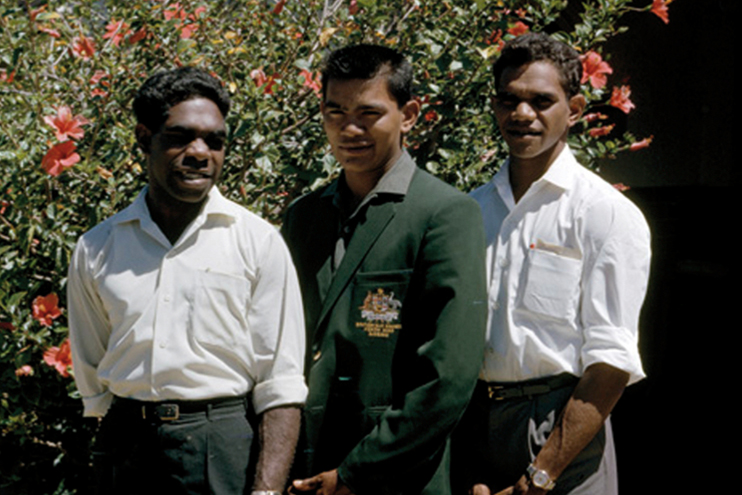
Boxers Jeff Dynevor, Adrian Blair and Eddie Barney at the Perth 1962 Games.
Dynevor and Hobson’s iconic performances in their individual disciplines made history by winning the first gold medals by Australian indigenous athletes at the Commonwealth Games. Hobson was our first gold medal winner and he set a new Commonwealth record in high jump, with an impressive 2.11m jump.
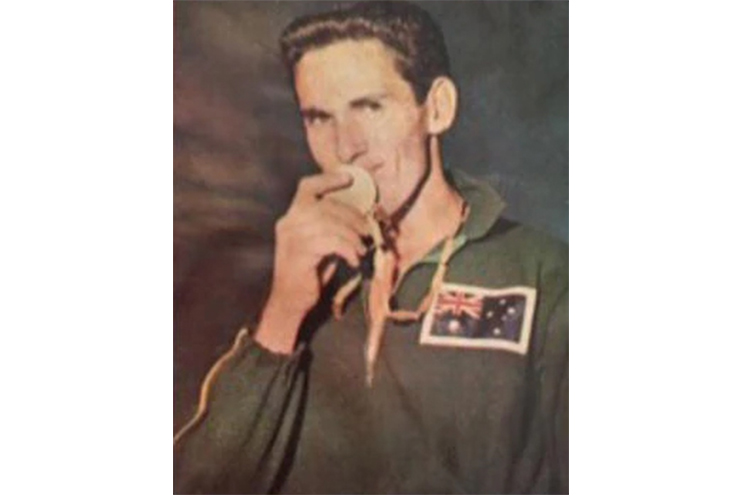
Percy Hobson won gold in the men’s high jump at the Perth 1962 Games. (CGA Archive)
Ray Barrett was the first Aboriginal and Torres Strait Islander Para-athlete to represent Australia, competing at the third Commonwealth Paraplegic Games in 1970 hosted in Edinburgh, Scotland.
He won two silver medals in the wheelchair dash and a further bronze medal in the wheelchair basketball.
At the fourth Commonwealth Paraplegic Games in 1974 hosted in Dunedin, New Zealand, Barrett returned to win gold, silver and bronze medals setting world records on all three occasions in the wheelchair dash.
Barrett was joined by fellow Para-athlete Kevin Coombs OAM in winning silver medals in wheelchair basketball at the same Games.
Coombs captained the silver medal-winning team.
At the Auckland Games in 1990 Cathy Freeman OAM competed in her first Commonwealth Games where she won gold as a member of the 4 x 100 metres relay team at just 17-years-old.
She became the first Aboriginal woman to represent Australia and win a gold medal at the Commonwealth Games.
The 1994 Commonwealth Games in Victoria, Canada saw Australia represented by seven Aboriginal and Torres Strait Islander athletes.
By this time Freeman was fast becoming Australia’s golden girl, and she once again delivered winning another two gold medals in the 200m and 400m events.
After her 400m win, Freeman celebrated by adorning both the Australian and Aboriginal flags as she completed a victory lap.
Freeman’s bold moves started a national conversation about reconciliation, and it remains an iconic moment in Australian sport and our national story to this day.
Since then, many Australian athletes felt safer to celebrate their heritage in sporting teams nationwide.
With this success, she became the first Aboriginal and Torres Strait Islander female to win an individual medal at a Commonwealth Games for Australia.
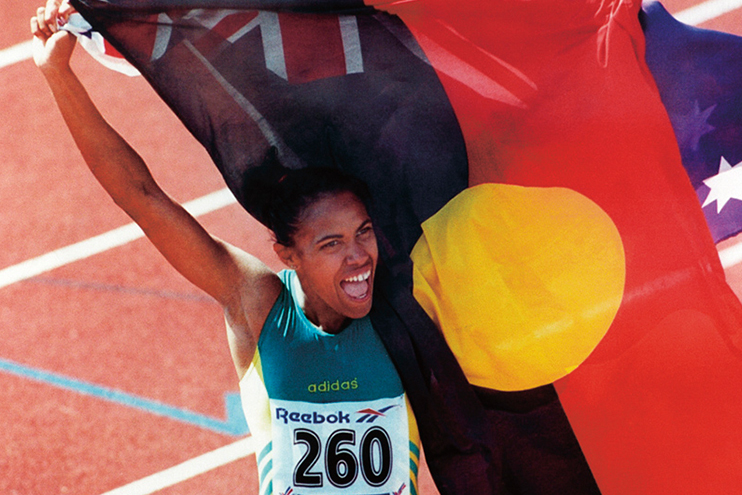
Cathy Freeman celebrating after winning gold at the Victoria 1994 Commonwealth Games. (CGA Archive)
At the Victoria 1994 Commonwealth Games, Freeman and fellow track athlete Kyle Vander-Kuyp became the first Aboriginal and Torres Strait Islander athletes to appear at multiple Commonwealth Games, following their debuts in Auckland four years earlier.
At the same Games, Samantha Riley OAM won three gold medals in the 100m and 200m breaststroke and the 4x100m medley relay becoming Australia’s first Aboriginal and Torres Strait Islander female Team Member in the pool.
Robert Peden went on to win gold in the men’s 54kg boxing and Katie Mitchell Sigsworth became the first Australian Aboriginal and Torres Strait Islander athlete to compete in gymnastics for Australia, taking home a silver medal as a part of the rhythmic gymnastics team.
The 1998 Australian Commonwealth Games team included seven Aboriginal and Torres Strait Islander athletes. Hosted in the Malaysian capital Kuala Lumpur the Games introduced team sports.
This addition of team sports saw Aboriginal and Torres Strait Islander netballer Nicole Cusack bring home gold as a member of the Australian Diamonds and Rugby 7s players Jim Williams and Brendan Williams win bronze.
The Kuala Lumpur Games witnessed a historic feat when Aboriginal and Torres Strait Islander hockey player turned sprinter Nova Peris OAM, made headlines after successfully switching from winning Olympic gold with the Hockeyroos at the Atlanta 1996 Olympics to athletics.
Peris won Commonwealth gold medals in the women’s 200m and as part of Australia’s 4x100m relay team at the 1998 Commonwealth Games.
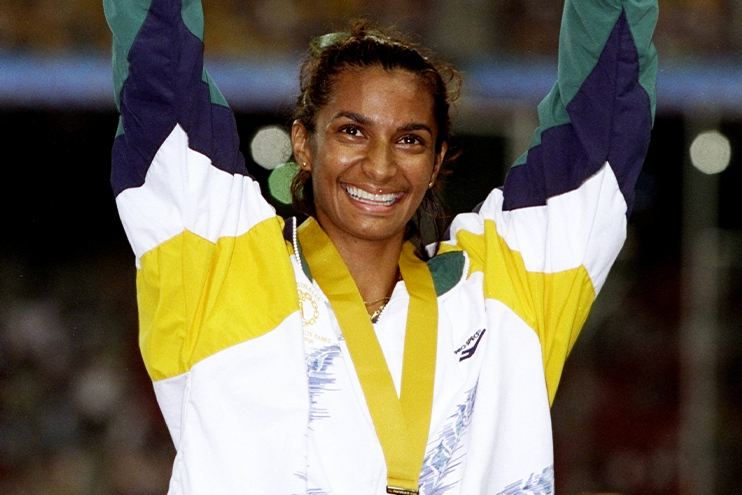
Nova Peris celebrates winning gold in the women’s 200m at the Kuala Lumpur 1998 Commonwealth Games. (Getty Images)
At the Manchester 2002 Commonwealth Games, Aboriginal and Torres Strait Islander Para-swimmer Ben Austin OAM made his Commonwealth Games debut, winning gold in the multi-disability 50m and 100m freestyle.
Daniel Geale also went on to win gold in the Men’s 67kg boxing.
With the Games back on home soil in Melbourne in 2006, Australia was represented by six Aboriginal and Torres Strait Islander team members in the athletics, swimming and boxing teams.
Discus thrower Benn Harradine attended the first of his four consecutive Games, alongside hurdler Kyle Vander Kuyp who was competing at his fourth and final Games.
Both these athletes hold the record for the most Commonwealth Games attended by Aboriginal and Torres Strait Islander athletes.
Benn Harradine would go on to win a gold medal in the men’s discus in 2010 in Delhi.
A record number of eight Aboriginal and Torres Strait Islander athletes attended the Delhi 2010 Commonwealth Games.
Kookaburra team members Des Abbott and Joel Carroll secured gold medals in the hockey, whilst Shane Parker attended the first of two consecutive Games representing Australia as the first Aboriginal and Torres Strait Islander male in the sport of wrestling.
Swimming sensation Austin won gold again in the Para-swimming S8 100m freestyle.

Benn Harradine won gold in the men’s discus at the Delhi 2010 Commonwealth Games. (Getty Images)
At the Glasgow 2014 Commonwealth Games in Scotland, Nova Peris’ cousin Brooke Peris joined her family legacy of winning Commonwealth gold with the Hockeyroos.
Brooke would win silver on the Gold Coast just four years later and is the first Aboriginal and Torres Strait Islander female athlete to represent Australia in hockey at the Commonwealth Games.
At the Gold Coast 2018 Commonwealth Games not only were there a record equalling eight Aboriginal and Torres Strait Islander athletes on the team but the mascot for the Games was a proud blue koala named Borobi.
Borobi’s name translates to koala from a dialect used by the Yugambeh people, an Aboriginal Australian group from the Gold Coast region.
Borobi is proud to keep the languages of his people alive as the Yugambeh language ambassador – so proud he wears it on his chest for all to see – ‘Jingeri, I’m Borobi’, which means hello in Yugambeh language.
Borobi was an active part of the Gold Coast 2018 Games supporting the Australian athletes in their sporting endeavours whilst welcoming people to his hometown.
Borobi will live on as the Australian Team mascot for the Birmingham 2022 Games, continuing to spread his infectious energy whilst supporting the team.
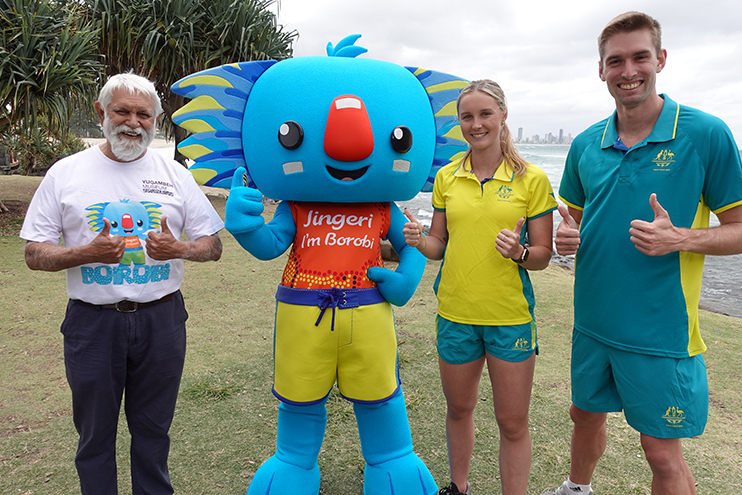
Borobi was joined by Yugambeh elder Uncle Ted and Gold Coast 2018 Team Members Riley Day and Cedric Dubler when Borobi was announced he was bound for the Birmingham 2022 Commonwealth Games. (CGA Archive)
At the Gold Coast 2018 Commonwealth Games, Taliqua Clancy, a proud Wulli Wulli and Goreng Goreng woman who grew up in Kingaroy, Queensland, made her Commonwealth Games debut in beach volleyball.
She became the first Aboriginal and Torres Strait Islander athlete to represent Australia in the sport, bringing home the silver medal with playing partner Mariafe Artacho del Solar.
Brandon Wakeling, a Wonnarua man, became the first Aboriginal and Torres Strait Islander athlete to represent Australia in weightlifting at a Commonwealth Games, finishing in sixth place.
The Gold Coast 2018 Commonwealth Games made history as the first ever multi-sport event to have a Reconciliation Action Plan.
The Unity symbol from those Games was used on elements of the Australian athlete uniforms and will also live on for future teams as part of the RAP artwork from Commonwealth Games Australia and the symbol will also feature on a range of elements of the Birmingham 2022 Australian Team.
Through the development of the Commonwealth Games Australia ‘Reflect’ Reconciliation Action plan, launched in May 2022, CGA is committed to recognising our Aboriginal and Torres Strait Islander athletes, increasing awareness of Aboriginal and Torres Strait Islander language, culture and histories and connecting with our Aboriginal and Torres Strait Islander communities.

